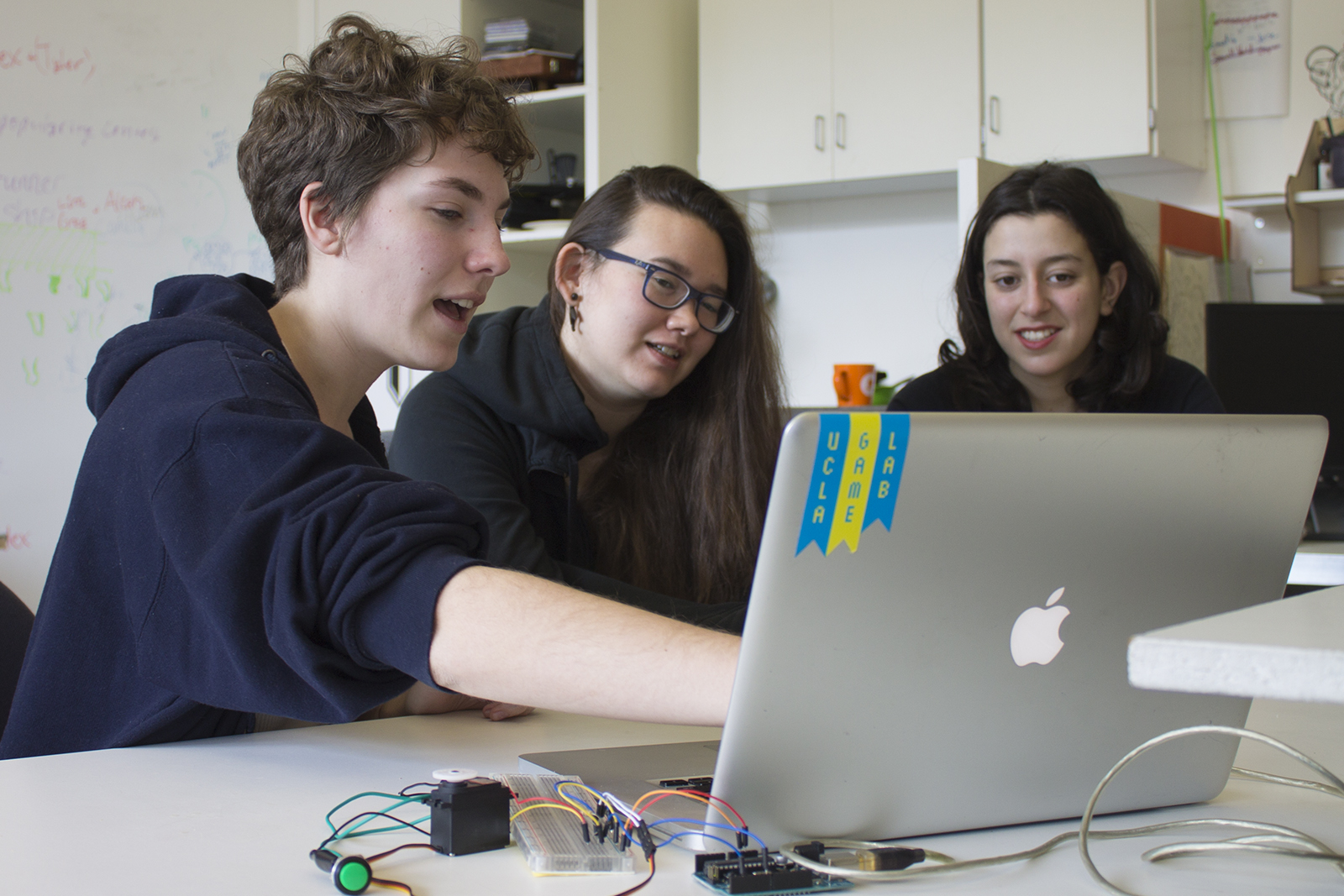UCLA Game Lab dispels stereotypes through female representation

Third-year English student Sophia Staab-Gulbenklan, Design | Media Arts alumna Adeline Ducker and Santa Monica College student Lilyan Kris share ideas about their games. (Jennifer Hu/Daily Bruin)
By Rebecca Sarvady
Feb. 5, 2015 12:00 a.m.
The original version of this article contained an error and has been changed. See the bottom of the article for more information.
A common stereotype exists when it comes to “the gamer.”
“The angry middle schooler or high schooler in his basement who just plays video games all day and eats Cheetos and doesn’t have any social skills,” said Adeline Ducker, a UCLA Design | Media Arts alumna.
But this stereotype does not hold up to recent reports. According to a study from the Entertainment Software Association, “the average American gamer is 31 years old and 48 percent are female.”
Ducker is a part of that female gamer population as well as the growing population of female game designers. She is one of the originally involved students of the UCLA Game Lab, an experimental and research-oriented laboratory where students from all majors can explore the art of game-making. The lab was officially founded in 2010 by Design | Media Arts professor Eddo Stern and a handful of students. Now the lab oscillates between 12-30 students every quarter.
Fairly new to the Game Lab, third-year English student Sofia Staab-Gulbenkian said the gamer stereotype is not only false but hypocritical.
“I don’t know why we still have that archetype. We’re all always online,” Staab-Gulbenkian said. “It’s like any stereotype – it takes only a gentle wisp of air to knock it down. … Everyone plays games.”
The gaming industry has had female developers and designers in the field since its origin. The classic arcade game “Centipede” was co-created by Atari employee Dona Bailey, who was the only female software engineer at the company at the time. In recent years, the number of female game developers has risen exponentially. According to an International Game Developers Association report, 22 percent of video game developers are female, 76 percent are male and 2 percent identify as transgender or “other”. While the amount of female developers are still a minority, their presence has nearly doubled since the 2009 IGDA report.
Gender has been a hot topic among the gaming community particularly in the issue of GamerGate – the name for the controversial internet movement regarding gender within the gaming community. What started as an frenzy over ethics in gaming journalism evolved into a larger argument about representation and sexism within the industry itself. One of the controversy’s lead players is Anita Sarkeesian, a media critic who founded “Feminist Frequency,” a web series that highlights sexist stereotypes within video games.
Ducker finds the amount of backlash in regards to Sarkeesian’s comments a representation of the greater sexism within the gaming community.
“It’s almost a ridiculous amount of sexism,” Ducker said. “For the fact that some lady is like, ‘Hey let’s make women (in video games) look like real women or it would be nice if women weren’t always getting killed or needing to be saved’ … (and) she’s gotten death threats.”
Ducker said she believes the more people of different ethnicities, genders and backgrounds that are involved in the gaming development process, the more the gaming community would benefit as a whole.
“I think making games with more representation will bring in more people who are interested in those kinds of things,” Ducker said. “There will be more diversity of voice, we’ll gain more power.”
Fourth-year Design | Media Arts student and UCLA Game Lab member Lauren Mahon said she agrees with Ducker that greater representation will not only dispel the gamer stereotypes within the gaming community, but also benefit society as a whole.
“There is not just one type of people,” Mahon said, “People at large stand to gain a sense of identity, a sense of place in community.”
Students at the Game Lab are encouraged to make games that may not appeal to a mainstream audience but instead deal with a wide scope of topics. Ducker is finalizing her video game titled “Classroom Aquatic,” about cheating in a classroom full of dolphins, Mahon is the creator of “Puff,” a pro-tobacco smoking card game and Staab-Gulbenkian is developing a video game exploring drug addiction and capitalism as inspired by a William S. Burroughs’ essay.
Lilyan Kris, a second-year student at Santa Monica College, is currently designing a tabletop game in the Game Lab about anxiety. Kris said she thinks games have the power to influence its players.
“I definitely think games are an effective way of spreading messages because they’re so accessible,” Kris said. “If you make something into a game then people are going to be so much more interested in interacting with it than if you were just lecturing … with games you’re getting directly involved.”
While Ducker said most students in the Game Lab are more likely to first identify as an artist rather than a gamer, everyone enjoys the personal expression that is allowed in game design. The Game Lab has inspired students like Staab-Gulbenkian to possibly pursue a career in gaming when she did not think it would be feasible.
“I never even considered making games because I didn’t know how to program,” Staab-Gulbenkian said, “I’m considering it as a career. I’m considering it just as a method to teach people or express myself and that alone is a great gift.”
Correction: Sofia Staab-Gulbenkian’s name was misspelled.


